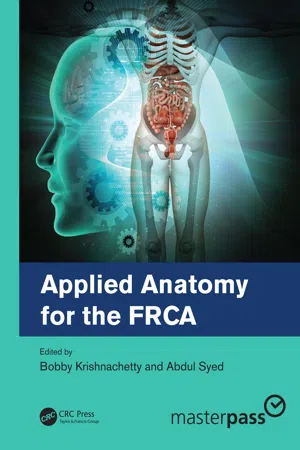
Applied Anatomy for the FRCA
- 330 pages
- English
- ePUB (mobile friendly)
- Available on iOS & Android
Applied Anatomy for the FRCA
About this book
Applied Anatomy for the FRCA covers the anatomical knowledge that trainee anaesthetists who are revising for the Primary and Final FRCA exams will need. The topics covered are derived from the FRCA curriculum and include the most up-to-date version of past exam questions, in order to ensure targeted and successful exam revision.
The content, illustrations and overall layout of this book ensure that common gaps in anatomical knowledge encountered by FRCA trainees are included. This reference is divided into sections pertaining to anatomical regions: head and neck, thorax, abdomen, spine, and the upper and lower limbs. The topics of importance to anaesthetists are presented under 'structures', 'circulation' and 'nervous system' (with relevance to regional anaesthesia). Each topic is extensively researched and presented in a simple format for maximum retention. This book makes learning and remembering applied anatomy as straightforward as possible.
Applied Anatomy for the FRCA supplements the knowledge required by trainee anaesthetists appearing for the FRCA exams. Clinical educators will also find it useful in teaching. It serves as a practical reference for anatomical knowledge at any point in an anaesthetist's career.
About the Editors
Dr Bobby Krishnachetty has been a Consultant Anaesthetist at Southend University Hospital since 2010 and a college tutor for six years. She completed her diploma in medical education and is the author of The Final FRCA Structured Oral Examination: A Complete Guide. She is also the organiser of the regional teaching for Core trainees in the East of England school of anaesthesia, as well as Founder of the 'Southend Viva Club' Primary and Final FRCA SOE revision courses for more than nine years, and Cofounder of MRCS OSCE webinars.
Mr Abdul Syed has been a Consultant Surgeon at Southend University Hospital since 2015. He is Lead for postgraduate teaching of surgical trainees, Cofounder of MRCS OSCE webinars and conducts Core surgical trainee interview skills courses. Mr Syed is also an Assessor for medical school interviews and an active participant in QI projects and research.
Frequently asked questions
- Essential is ideal for learners and professionals who enjoy exploring a wide range of subjects. Access the Essential Library with 800,000+ trusted titles and best-sellers across business, personal growth, and the humanities. Includes unlimited reading time and Standard Read Aloud voice.
- Complete: Perfect for advanced learners and researchers needing full, unrestricted access. Unlock 1.4M+ books across hundreds of subjects, including academic and specialized titles. The Complete Plan also includes advanced features like Premium Read Aloud and Research Assistant.
Please note we cannot support devices running on iOS 13 and Android 7 or earlier. Learn more about using the app.
Information
Head and Neck
1
- Scalp and base of skull
- Brain
- Pituitary gland
- Eye and optic tract
- Nose
- Sagittal section of head and neck
- Cross section at C6
- Larynx with grades at laryngoscopy
- Triangles of neck
- Arterial supply of head and neck
- Great veins of head and neck
- Cranial nerves – II, V, VII and X
- Scalp blocks
- Eye blocks
- Sub-Tenon’s block
- Retrobulbar block
- Peribulbar block
- Laryngeal nerve blocks
- Cervical plexus block
Structures
- Scalp and base of skull
- Brain
- Pituitary gland
- Eye and optic tract
- Nose
- Sagittal section of head and neck
- Cross section at C6
- Larynx with grades at laryngoscopy
- Triangles of neck
Scalp and Base of Skull
- Skin with hair follicles and sebaceous glands
- Connective tissue with neurovasculature of the scalp
- Aponeurosis (galea aponeurotica)
- Loose areolar connective tissue which serves as a plane of access in neurosurgery. It is also called the ‘danger zone of the scalp’ as infection from scalp can reach the meninges through emissary veins.
- Periosteum

- One each of the frontal, sphenoid, occipital and ethmoid bones
- Two of the parietal and temporal bones


| Foramen | Contents |
| Foramen caecum | Emissary vein from nose to superior sagittal sinus |
| Cribriform plate | Olfactory nerve Anterior ethmoidal nerve |
| Superior orbital fissure (Live Frankly To See Absolutely No InSult) | Lacrimal nerve (branch of ophthalmic nerve) Frontal nerve (branch of ophthalmic nerve) Trochlear nerve Superior branch of oculomotor nerve Abducens nerve Nasociliary nerve (branch of ophthalmic nerve) Inferior branch of oculomotor nerve Superior and inferior ophthalmic vein |
| Optic canal | Optic nerve Ophthalmic artery |
| Foramen rotundum | Maxillary nerve (V2) |
| Foramen ovale (O-MALE) | Mandibular nerve (V3) Accessory meningeal nerve Lesser petrosal nerve Emissary vein |
| Foramen spinosum (S-MEN) | Middle meningeal artery and vein Emissary vein Nervus spinosus |
| Foramen lacerum (L-GEMI) | Meningeal branch of ascending pharyngeal artery Emissary vein Traversed partially by Internal carotid artery Greater petrosal nerve |
| Auditory meatus | Facial nerve Vestibulocochlear nerve Labyrinthine vessels |
| Jugular foramen | Inferior petrosal sinus/sigmoid sinus Glossopharyngeal nerve Vagus nerve Accesory nerve Occ... |
Table of contents
- Cover
- Half-Title
- Title
- Copyright
- Contents
- Foreword
- Contributors
- Introduction
- CHAPTER 1 HEAD AND NECK
- CHAPTER 2 THORAX
- CHAPTER 3 ABDOMEN
- CHAPTER 4 SPINE
- CHAPTER 5 UPPER LIMB
- CHAPTER 6 LOWER LIMB
- CHAPTER 7 MISCELLANEOUS
- Index